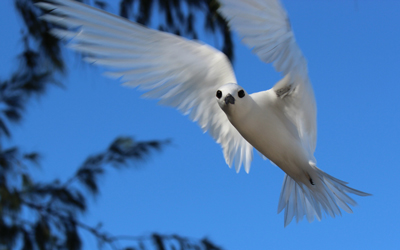Species of the Month – ʻApelila (April) 2023
Manu o Kū
Cygis alba rothschildi | White Tern/Fairy Tern

Ka Hōʻike ʻAno - Description
- Fairy terns mate for life. They are slender bodied and pure white. They have a bright black beak and shiny black eyes.
- They lay a single egg on a bare branch, or convenient crotch of large trees like our Bo tree, kiawe, and kukui trees.
- When the chick hatches it is a bright white bundle of fluff with bright black eyes and a sharp beak, ready to catch its own fish one day.
Ka Laulā Kaianoho - Distribution
- Manu o Kū spend the day hunting at sea as far as 120 miles from their roost, before returning home in the afternoon.
- Manu o Kū breed throughout the Northwestern Hawaiian Islands and on the island of O‘ahu.
- Outside of Hawai‘i, Manu o Kū breeds on islands throughout subtropical and tropical oceans, although breeding in the southern Atlantic Ocean is limited.
Ka Waiwai Hoʻoilina - Cultural Significance
- Native Hawaiian and other Pacific voyagers relied on sightings of these birds as a sign that land was close at hand.
- Manu o Kū go out to sea in the morning to feed on shrimp, and return to land at night to rest.
- Observing the daily flight patterns of these birds can indicate the direction of islands far out of the range of sight.
ʻIkepili Hoihoi - Interesting Fact
- Fairy terns lay their eggs directly onto a surface like a tree branch or cliff ledge. When the chicks hatch, they use their sturdy claws to grip onto the surface, which helps them weather even the strongest winds and storms.
- The chicks have webbed feet like a seabird, with claws on the tips that can cling to the high tree branches.



